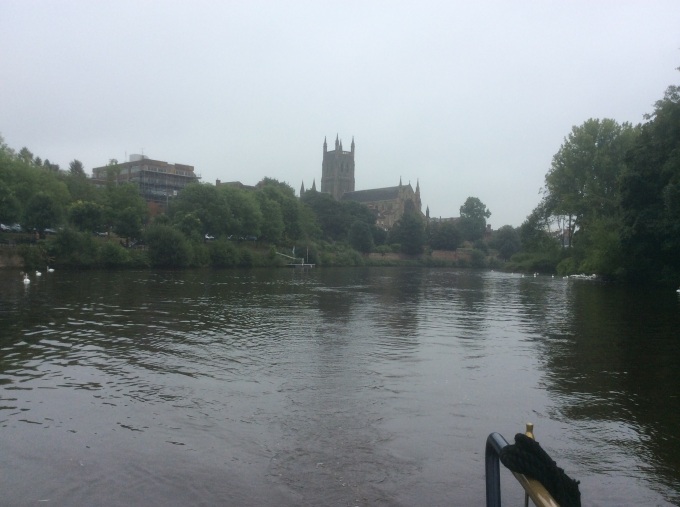Friday morning: we knew it was going to turn into a hot day, so an early start was called for. By 7.30 a.m. we had breakfasted (rather meagrely, as we were running out of supplies by now), made good use of the facilities, and slipped our moorings. I walked round to the first of the narrow staircase locks to get the top lock open, as I knew Ernest would have a difficult manoeuvre, needing to navigate between all the moored boats then make a sharp 90 degree turn towards the lock – and it was windy. Last night the water level in the basin seemed a couple of inches too high and water had been overflowing the top lock gates, but the level had gone down a little overnight and I soon had the gates opened. Ernst came swinging round the corner – no collisions – and we were away. A little help at the bottom staircase from a boater waiting for his boat to be released from the dry dock. On the river by 8.00 a.m.
The River Severn was on ‘amber’, ie water levels slightly raised and flowing fast, but levels were dropping so we were fine. The Lock keeper told us this was rain which had fallen on the Welsh hills a couple of days ago. Yes, we remember that rain.
An uneventful stretch down to Hawford where we made a sharp turn left into Hawford Lock which leads into the Droitwich Canals. Very nice timing – a boat had just left the lock and the skipper opened the gates for us. His crew told us they had had to leave their boat in Droitwich marina for two weeks, as the Severn had been closed to navigation following the extreme rain – the same rain we had encountered in Llangollen. We could see from the deposited mud and debris that the river had indeed been very high.
So, up through 8 locks into the centre of Droitwich. The wide locks of the Droitwich barge canal were hard work after the narrow locks of the Staffs and Worcs and the Shroppie.
Ernest kindly did the heavy and tricky swing bridges in Vines Park, where he encountered a group of 4 police officers looking for something (weapons? drugs?) in the dog waste and other bins – from a distance, I thought they were were an overmanned waste bin emptying team – it’s so hard to spot a police officer these days, now they no longer wear those police hats that Dixon of Dock Green always wore.
We paused briefly near Waitrose so I could dash in and grab us a couple of wraps for lunch. Then just 5 more locks, including the 4” barge lock, and the final staircase, which seemed to take ages to get through, by the time you’ve opened the bottom gates, let the boat in, closed the bottom gates, filled the top lock, emptied the top lock into the bottom lock, opened the middle gates, let the boat into the top lock, closed the middle gates, filled the top lock (again), opened the top gates, let the boat out, closed the top gate – and all on a Waitrose wrap, and no coffee or tea since 9.00 a.m.
It was still windy, but Ernest executed a perfect manoeuvre into the marina, and an almost perfect manoeuvre into our mooring slot (just slightly kissing the next boat, which fortunately had no one on board). 2.00 p.m. – and then we worked oh so efficiently as a team to pack, clean, and prep the boat for leaving. As always, the land took some time to stop swaying and rocking, and the road traffic once we got driving seemed unnecessarily fast.
Having called off at Tesco on the way, we arrived home at 5.30 p.m. to find the garden even more rampant, the beans looking thirsty, and the buds off Ernest’s favourite rose devoured – we suspect our resident pheasant.
And to discover a flier for ‘pub and pizza night’ at the Colony Hall (our local community hall) – so that’s dinner sorted then.
Friday’s statistics: 19 Locks, 15.5 miles and 3 swing bridges in 6.4 engine hours.
Our journey this week from Marbury has been 85 Locks and 90 miles in 44.4 engine hours over 5 days.
Total journey, Droitwich to Llangollen and back: 194 Locks, 250 miles, 120.7 engine hours.
